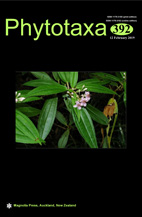Abstract
Strains with complete morphological match to Pleurocapsa fuliginosa and P. minor were isolated from Oahu, with another strain matching P. minor isolated from a wet rock face in Utah. Phylogenetically these baeocyte and pseudofilament producing strains fell in a single well-supported clade among a number of pleurocapsalean strains. They were sister to a clade of baeocyte-producing strains that lack the ability to form psuedofilaments and likely belong in an as-yet-to-be-described genus. Strains putatively named Pleurocapsa are scattered throughout the Pleurocapsales and Chroococcales, indicating a need for clear definition of the genus so that revisionary work and alpha-level taxonomy can move forward. To satisfy this need, P. fuliginosa HA4302-MV1 and P. minor HA4230-MV1 were chosen as neotype and epitype, respectively, establishing the genus based on molecular sequence data. In addition to the distinctive morphology of the genus, all Pleurocapsa species for which 16S-23S ITS regions are available have an unusually long, branched D5 helix at the termination of the ITS region. The sister clade of strains that lack the ability to form pseudofilaments also possess an unusually long and branched D5 helix as well, suggesting that this feature of the ITS region may be a family-level synapomorphy.

